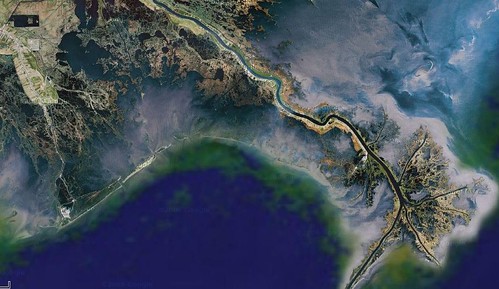Electricity From Salty Water
Posted by Big Gav in osmosis, salt, water
Physics Central has an article on generating power using salinity differentials between different bodies of water (which I once dubbed "The Power Of Osmosis") - Electricity From Salty Water.
A device that gleans usable energy from the mixing of salty and fresh waters has been developed by University of Milan-Bicocca physicist Doriano Brogioli. If scaled up, the technology could potentially power coastal homes, though some scientists caution that such an idea might not be realistic.
Extracting clean, fresh water from salty water requires energy. The reverse process?mixing fresh water and salty water?releases energy. Physicists began exploring the idea of extracting energy from mixing fresh and salty waters, a process known as salination, in the 1970s. They found that the energy released by the world?s freshwater rivers as they flowed into salty oceans was comparable to "each river in the world ending at its mouth in a waterfall 225 meters [739 feet] high," according to a 1974 research paper in the journal Science. But those who have chased the salination dream have collided with technological barriers.
Brogioli has developed a new approach to salination, a prototype cell that relies on two chunks of activated carbon, a porous carbon commonly used for water and air filtration. Once he jump starts the cell with electric power, all that is required to produce electricity are sources of fresh and salty water and a pump to keep the water flowing. When the separate streams of salty and fresh water mix, energy is released.
A typical cell would require about three dollars worth of activated carbon, and, given a steady flow of water, the cell could produce enough electricity to meet the needs of a small house. It's the equivalent, in hydroelectric power, of running your appliances from a personal 100 meter (338 feet) high waterfall.
Salination would be an ideal technique for places where fresh and salty waters naturally mix, such as estuaries, according to Brogioli. He said that a coastal community of about a hundred houses could set up a plant with minimal damage to the ecosystem. "A salinity difference plant will be much smaller than a solar plant," he said. The only waste product is slightly brackish water that can be poured directly into the sea or, Brogioli suggested, into ponds that support estuary-friendly flora and fauna.
Instead of using fresh water, an increasingly scarce global resource, a salinity power plant could use water that is polluted or slightly contaminated with salt, giving new life to unusable water, Brogioli said. Seawater could also be mixed with high-salinity water, obtained by evaporating seawater?perfect for a desert community with little fresh water but sunshine to spare.
"Preliminary evaluations confirm that the setup can be scaled up to very big plants suitable for powering whole cities," said Brogioli.
Scientists agree that Brogioli's concept is sound but are cautious to declare it practical on a large scale.
"I don't see any reason why it should not work," said Yury Gogotsi, director of the A.J. Drexel Nanotechnology Institute at Drexel University in Philadelphia. "Capacitor desalination has been demonstrated and commercialized, and this can be called reverse capacitance desalination. It appears to be a logical approach. Of course the challenge is the practical implementation."
George Crabtree, a senior scientist at Argonne National Laboratory in Illinois, said he likes that the device extracts the energy as immediately usable electricity. But he sees difficulties in scaling up from a lab experiment to megawatt plants that could compete with wind turbines or other clean energy sources. Crabtree thinks the water requirements might limit the technology to large river deltas, like the mouth of the Mississippi. The energy it could potentially generate, he said, "is significant ... [but] not enough to solve everyone's problems."







